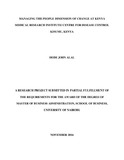| dc.description.abstract | People are the most valuable resource of the organization therefore change initiatives achieve desired result when there is an inclusion of all the people in change implementation. The study was done at KEMRI/CDC Kisumu to determine how the people dimension of change has been managed; establish challenges and, remedies to the challenges of managing the people dimension of change. The study was carried out using case study. The research was conducted by collecting both primary and secondary qualitative data. Primary data was gathered through the use of interview guide and administered through direct personal interview to heads of various departments who are directly involved in different ways with change at KEMRI/CDC Kisumu while secondary data was obtained from existing database. The study found that some of the changes that targeted employees were personnel transfer, terminations and electronic clocking. The study found that the people dimension of change at KEMRI/CDC Kisumu has been managed by the use of open door policy to access and pass change information. Communication was made through internal memos, emails, suggestion boxes, trainings, leader mentorship, counseling and work group meetings. The study established that the staff showed low acceptance to changes characterized with expression of disappointment and anxiety. Further, effective management of people dimension of change was achieved through knowledge building, trainings, workshops, close follow up, continuous monitoring and evaluation, regular meetings, counselling and trainings. From the findings, the study concludes that there is need to involve all employees before change is operationalize, behavioral resistance is a common reaction to change and there is need for frequent training, workshops and timely communication on the need for change. There is need for open door policy and close follow-up on change initiatives to achieve desired behavior. The implication of the study was that change initiatives succeed when people are involved in change implementation. Behavioral change resistance is as a result of people not understanding the need for change. The study was limited to the people dimension of change at KEMRI/CDC Kisumu, Kenya. The study did not explore the extent to which reaction of different people to change influence research findings of KEMRI/CDC Kisumu, Kenya. The study was carried out using case study and the information collected did not include the views of stakeholders in other organizations of the same sector research. It was difficult to make inferences on people’s change due to few interviewees and unpredictable human behavior. The study was limited to KEMRI/CDC Kisumu, Kenya which is not a representative of the health sector research. The findings are unique and this may not be sufficient to arrive to a general conclusion on managing the people dimension of change. The study suggests that the same study needs to be conducted in future to explore further the extent to which the reaction of different people to change influences research findings of KEMRI/CDC Kisumu, Kenya. | en_US |



